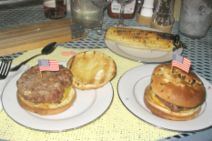Hamburger
A hamburger (or hamburg or burger) is a sandwich made with a bun containing a patty of ground, cooked meat that is almost always beef, usually served with condiments such as relish, mustard, or ketchup. The bun is usually but not always toasted or otherwise warmed.
Most authorities consider that the word "hamburger" is derived from the German city of Hamburg, which once enjoyed prosperous commerce with the Baltic Provinces in Russia, where shredded raw meat (we now know it as steak tartare) was popular. [1] Around 1900, a popular meal in the United States was "Salisbury steak," cooked, ground steak, which was promoted by a food faddist named Dr. J. H. Salisbury as a cure for innumerable ailments. At some point in the late 19th or early 20th century hamburgers as we know them, cooked patties within a roll, made their first appearance in the United States, although exactly where and when is still debated.
Generally considered to be an informal meal or a convenience food, its meat can be grilled, fried, broiled, microwaved, or steamed. One of its most popular variations, a hamburger served with melted cheese on top, is called a cheeseburger.
Variations
Many cultures over the centuries have cooked finely chopped or ground meats in shapes such as meatballs, patties, or steaks, often flavored with other ingredients. The Larousse Gastronomique, for instance, gives a half-dozen Hungarian, German, and Austrian recipes for what it calls Keftedes, all translated as variations on "hamburgers". [2]
